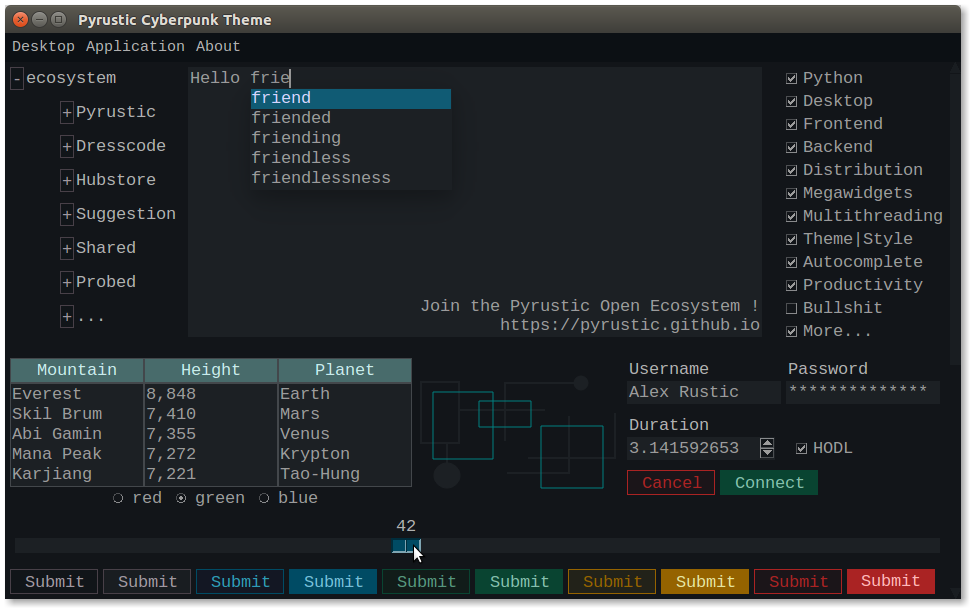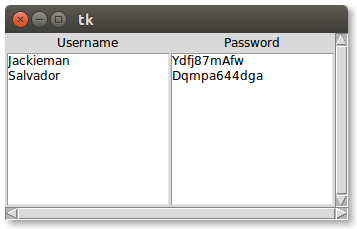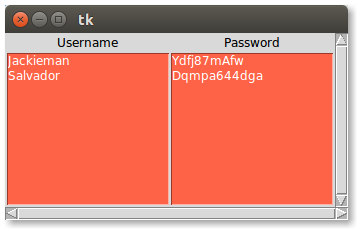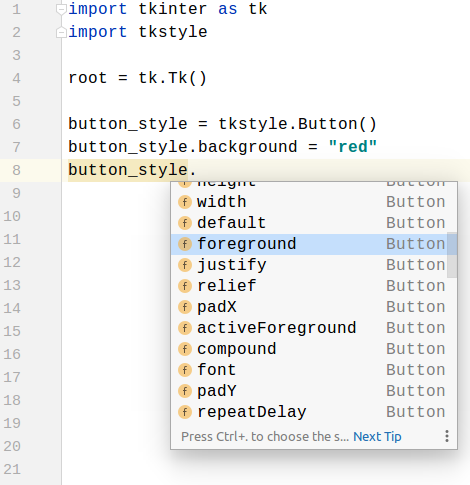https://github.com/pyrustic/tkstyle
Create styles and themes for your Python desktop applications
https://github.com/pyrustic/tkstyle
beautiful gui library lightweight pyrustic python style styling theme theme-builder theming theming-paradigm tkinter
Last synced: 2 months ago
JSON representation
Create styles and themes for your Python desktop applications
- Host: GitHub
- URL: https://github.com/pyrustic/tkstyle
- Owner: pyrustic
- License: mit
- Created: 2021-07-16T19:15:46.000Z (over 4 years ago)
- Default Branch: master
- Last Pushed: 2022-03-21T20:43:08.000Z (over 3 years ago)
- Last Synced: 2025-07-03T06:05:42.959Z (4 months ago)
- Topics: beautiful, gui, library, lightweight, pyrustic, python, style, styling, theme, theme-builder, theming, theming-paradigm, tkinter
- Language: Python
- Homepage: https://pyrustic.github.io
- Size: 27.3 KB
- Stars: 15
- Watchers: 2
- Forks: 1
- Open Issues: 0
-
Metadata Files:
- Readme: README.md
- License: LICENSE
Awesome Lists containing this project
README
# TkStyle
`TkStyle` is a `Python` library to style your `GUI` with a modern and pragmatic paradigm. It's part of the [Pyrustic Open Ecosystem](https://pyrustic.github.io).

Cyberpunk theme made with TkStyle
[Installation](#installation) | [Reference](https://github.com/pyrustic/tkstyle/tree/master/docs/reference#readme) | [Cyberpunk](https://github.com/pyrustic/cyberpunk-theme)
## Overview
`TkStyle` is a styling library for `Tkinter` that takes advantage of the autocomplete feature of IDEs so that you hardly need any prior Tkinter styling knowledge.
Each Tkinter widget has a set of options that allow you to define its look. For example, the `tkinter.Button` widget has the `background` and `foreground` options to change the background color and the text color on the button respectively.
`TkStyle` reproduces for each widget a class which bears the name of the widget and which has attributes representing the options to modify the appearance of the widget.
Here is the definition of the `tkstyle.Button` class which is supposed to modify the look of the `tkinter.Button` widget:
```python
class Button(_Style):
_CLASS_NAME = "Button"
def __init__(self):
super().__init__()
self.activeBackground = None # "#ececec"
self.activeForeground = None # "#000000"
self.anchor = None # "center"
self.background = None # "#d9d9d9"
self.borderWidth = None # 1
self.compound = None # "none"
self.default = None # "disabled"
self.disabledForeground = None # "#a3a3a3"
self.font = None # TkDefaultFont
self.foreground = None # "#000000"
self.height = None # 0
self.highlightBackground = None # "#d9d9d9"
self.highlightColor = None # "#000000"
self.highlightThickness = None # 1
self.justify = None # "center"
self.padX = None # 3
self.padY = None # 1
self.relief = None # "raised"
self.repeatDelay = None # 0
self.repeatInterval = None # 0
self.state = None # "normal"
self.underline = None # -1
self.width = None # 0
self.wrapLength = None # 0
```
Since a style is a `Python` object and thanks to the autocomplete feature of the IDEs, we no longer need to know by heart the options to change the look of widgets:
Since Tkinter is a mature GUI toolkit, it sometimes indicates the legal values of an option when you don't set the correct value. For example, if you don't know which values the `relief` option of the `tkinter.Button` widget accepts, you can put an arbitrary string like `oops` and at runtime Tkinter will raise an informative exception:
```bash
_tkinter.TclError: bad relief "oops": must be flat, groove, raised, ridge, solid, or sunken
```
These details combined make `TkStyle` a great modern paradigm for GUI styling that will save you a lot of time.
## Style an instance of a widget
This code snippet shows how to style the instance of a widget:
```python
import tkinter as tk
import tkstyle
root = tk.Tk()
# create and pack button_1
button_1 = tk.Button(root, text="Button 1")
button_1.pack(side=tk.LEFT, padx=5, pady=5)
# create and pack button_2
button_2 = tk.Button(root, text="Button 2")
button_2.pack(side=tk.LEFT, padx=5, pady=5)
# create the button_style
button_style = tkstyle.Button()
button_style.background = "tomato"
button_style.foreground = "white"
# apply the button_style to button_2
button_style.target(button_2)
# mainloop
root.mainloop()
```

Custom style applied to a button
## Style a megawidget
A megawidget is a custom widget built with other native widgets.
For example, `megawidget.Table` is built with `tkinter.Listbox`, `tkinter.Label`, and `tkinter.Scrollbar`.

Table
Since a megawidget is not a native widget, it does not have a class that represents it in `TkStyle`.
So how do you style a megawidget ?
Well, megawidgets subclass `tkinter.Frame` or `tkinter.Toplevel` and `TkStyle` allows styles to be nested like [Matryoshka dolls](https://en.wikipedia.org/wiki/Matryoshka_doll).
Here's how we can style the Listboxes that make up a Table:
```python
import tkinter as tk
import tkstyle
from megawidget.table import Table
root = tk.Tk()
# table titles
titles = ("Username", "Password")
# table data
data = [("Jackieman", "Ydfj87mAfw"),
("Salvador", "Dqmpa644dga")]
# create and pack table
table = Table(root, titles=titles, data=data)
table.pack()
# create the listbox_style
listbox_style = tkstyle.Listbox()
listbox_style.background = "tomato"
listbox_style.foreground = "white"
# create the table_style
table_style = tkstyle.Frame() # megawidgets subclass tk.Frame
# add the listbox_style to the table_style by specifying
# a XResources-like pattern that matches Listboxes: "*Listbox"
table_style.add(listbox_style, pattern="*Listbox")
# apply the table_style to table
table_style.target(table)
# mainloop
root.mainloop()
```

Table with a custom style
## Create a theme
A theme is a collection of styles. While a style allows you to change the look of a particular (mega)widget instance, a theme allows you to apply a style to multiple (mega)widgets or also to a particular widget.
In this example, we'll create a theme that changes the look of all the buttons:
```python
import tkinter as tk
import tkstyle
def get_button_style():
# create the button_style
button_style = tkstyle.Button()
button_style.background = "tomato"
button_style.foreground = "white"
return button_style
def get_theme():
# create the theme
theme = tkstyle.Theme()
# add the button_style to the theme
button_style = get_button_style()
theme.add(button_style, pattern="*Button")
# the previous line could be this:
# theme.add(button_style)
# When you don't set a pattern, by default, the added style
# class name prefixed with "*" is used as pattern
return theme
root = tk.Tk()
theme = get_theme()
theme.target(root)
# create and pack button_1
button_1 = tk.Button(root, text="Button 1")
button_1.pack(side=tk.LEFT, padx=5, pady=5)
# create and pack button_2
button_2 = tk.Button(root, text="Button 2")
button_2.pack(side=tk.LEFT, padx=5, pady=5)
# mainloop
root.mainloop()
```

Custom theme for buttons
In this other example, the theme contains a style that targets a particular instance of `tkinter.Button`:
```python
import tkinter as tk
import tkstyle
def get_button_style():
# create the button_style
button_style = tkstyle.Button()
button_style.background = "tomato"
button_style.foreground = "white"
return button_style
def get_theme():
# create the theme
theme = tkstyle.Theme()
# add the button_style to the theme
button_style = get_button_style()
theme.add(button_style, pattern="*mybutton")
return theme
root = tk.Tk()
theme = get_theme()
theme.target(root)
# create and pack button_1
button_1 = tk.Button(root, text="Button 1")
button_1.pack(side=tk.LEFT, padx=5, pady=5)
# create and pack button_2
button_2 = tk.Button(root, name="mybutton", text="Button 2")
button_2.pack(side=tk.LEFT, padx=5, pady=5)
# mainloop
root.mainloop()
```

Custom theme but constrained to fit to button_2
So in short:
- You don't need to know the options by heart to customize the look of a widget.
- You don't need to learn yet another DSL.
- `TkStyle` uses object oriented programming and takes advantage of your IDE.
- There is a flag that allows TkStyle to forgive your mistakes (by default ignore_error = True), so your app doesn't crash just because you misspelled a color name.
- You can determine which widgets used a given style since a style is just a Python object and therefore your IDE can locate usages.
- You can use code organization best practices to manage the styling aspect of your project since `TkStyle` lets you use object oriented programming.
I invite you to check out the [Cyberpunk dark theme](https://github.com/pyrustic/cyberpunk-theme) which uses the `TkStyle` library.
```bash
$ pip install cyberpunk-theme
```
```python
import tkinter as tk
from cyberpunk_theme import Cyberpunk
from cyberpunk_theme.widget.button import get_button_style_4
root = tk.Tk()
# apply the Cyberpunk theme to the GUI
cyberpunk_theme = Cyberpunk()
cyberpunk_theme.target(root)
# write your awesome code here
# ...
# ...
button = tk.Button(root, text="Button")
button.pack()
# do you need to set dynamically a specific style to a button ?
# there are 10 styles for buttons ! from the black to the red style !
button_style_4 = get_button_style_4()
button_style_4.target(button)
# mainloop
root.mainloop()
```
## Installation
### First time
Install for the first time:
```bash
$ pip install tkstyle
```
### Upgrade
To upgrade `TkStyle`:
```bash
$ pip install tkstyle --upgrade --upgrade-strategy eager
```
